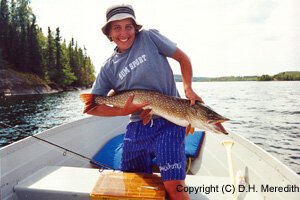A Northern Honey Hole
Second Place
Magazine Feature Article
(Fishing)
Outdoor Writers of Canada
2004 National Communications Awards
by Don Meredith © 2003
(first published in the 2003 Alberta Guide to Sportfishing Regulations)
I've fished my share of "honey holes" in my life. You know, places where the fishing is so red-hot that the retelling of their stories makes them legends in our lives. The earliest such legend I can remember was when I was about six-years-old. Our family was visiting relatives in Texas and an uncle told us about a spot down a rural road where you could catch what I believe were a kind of sunfish (probably warmouth) through a hole in an old wooden bridge. Now, fishing was a passion in our family. So, it wasn't long before we were standing on that bridge. It spanned a slow and deep East Texas creek that meandered through a forest of wild magnolias and long-needle pines.
As I remember it, the bridge wasn't very wide — just some old planks nailed across two decaying beams. The hole in the planks was triangular in shape, like someone had fashioned it with a saw. There wasn't enough room for more than one person to fish the hole, so that job was given to me — probably because I was the most excited about fishing that day. My father and older brother fished the same water but over the side of the bridge.
We dangled baited hooks into the water, and I soon had a fish on the line. In fact, that excited little boy landed a whole "mess o' fish" that day through the hole. Even though my father and brother were fishing just a few feet away, they caught very few, if any, until I reluctantly gave up possession of the hole. Then they caught their share and their right to be part of the legend. We took home our mess o' fish and had a big fish fry that evening where the story was first told and the legend created. Now, that legend comes up again and again at each family reunion — and I'm sure truth has been blurred with fiction, but at least the memory is maintained.
Over the years, I've found other honey holes in streams and lakes in the Sierra Nevada, the Washington Cascades, the eastern slopes of our Rockies, and even on the rolling ocean where the "hole" was more of a moving target than an actual place. However, I encountered my most memorable honey hole on a fly-in trip I made with my daughter, Joanne, and our friends, Keith Kivett and Bill Erwin, to one of the Canadian Shield lakes in northeastern Alberta.
Alberta doesn't have the selection of northern lakes our neighbors Saskatchewan and Manitoba boast, but the ones we have are no less jewels in both scenery and fishing opportunity. They're kept that way by being remote and being under the care of fishing outfitters that realize the future of their businesses rides on how well their fisheries are managed. A few of these lakes have full-service lodges that provide every amenity for the angler. Such luxury is enjoyable because all you have to concern yourself with is the fishing. But our little group of anglers that periodically makes a pilgrimage to the North prefers to experience the northern wilderness a little closer to the bone. We choose to be responsible for our own day-to-day needs, from preparing our own meals to exploring the lakes on our own. Not only is it easier on the pocketbook, we feel we get more out of the experience. Northern Sport Fishing and Mikisew Sport Fishing out of Fort McMurray offer such opportunities by providing minimal yet comfortable facilities in camps at several lakes in northern Alberta. Anglers bring their own food, bedding, clothing, other personal gear, and of course fishing gear. The outfitters provide a cabin with bunks and mattresses, propane stove and refrigerator, cooking utensils and dishes; and aluminum boats, motors and pre-mixed fuel.
On this particular trip, we were fishing for lake trout and northern pike in late July on Charles Lake near the Northwest Territories border. In the first few days, we had some success with lake trout — Keith caught a 22 pounder the first trip out of camp. We had also caught the occasional large pike. But most of the fishing was hit and miss — no particular honey holes to capture the imagination — and that was part of the adventure, exploring the lake to find the elusive honey hole.
On our fourth day, we checked out a long arm of the lake that extended into the boreal forest of jack pine, black spruce and rock. We investigated one particularly large, shallow bay that looked promising for pike. Sure enough, at the edge of the deep water, Joanne hooked into a large one that gave her quite a battle. She finally got it to the boat and it weighed 15 pounds. After the requisite photograph, she quickly released it. It wasn't long before we were all hooking up with large pike. Poles were bent double, and smaller pike were quickly released to help boat partners with larger fish.
We'd found our honey hole. The fish were striking hard and fast at just about anything that was big and flashy. Knowing this was a treasure to be preserved and cherished, we took extra precautions to make sure all the fish were released as unharmed as possible. We quickly learned that landing nets were not appropriate for these fish that were running between 12 and 20 pounds. Once in the net, they would quickly twist and turn and make their extraction very difficult, further stressing the fish. The net also threatened the fish by removing the mucous layer that protects them from infection. We realized the best release was one in the water where handling was minimized.
After a couple of hours, we'd had enough and beached the boats on a rocky peninsula to make our shore lunch of some lake trout we had caught earlier that morning. The delicate taste of the fast-fried filets mixed with the perfect weather, good company and the satisfying fatigue from a great morning of fishing could not be matched anywhere.
Once rested, we returned to our boats and again tried our luck at the honey hole. The pike were still there, and we caught a few, but they weren't biting at the same frenzied pace. We fished the spot for less than an hour before turning our boats for the long trip back to camp. That evening over another meal of fresh pike and trout fillets, we praised the honey hole and the fighting tenacity of the northern pike, a truly legendary predator.
The following couple of days we made some trips back to that hole. We caught some pike but not like we'd done the first time. Most of the fish had either moved on to other places to feed or we had just caught them at a particularly opportune moment that first time. Perhaps that's what honey holes are really all about — being at the right place at the right time. And maybe that's what makes them special — true legends that only come along once in a lifetime.


